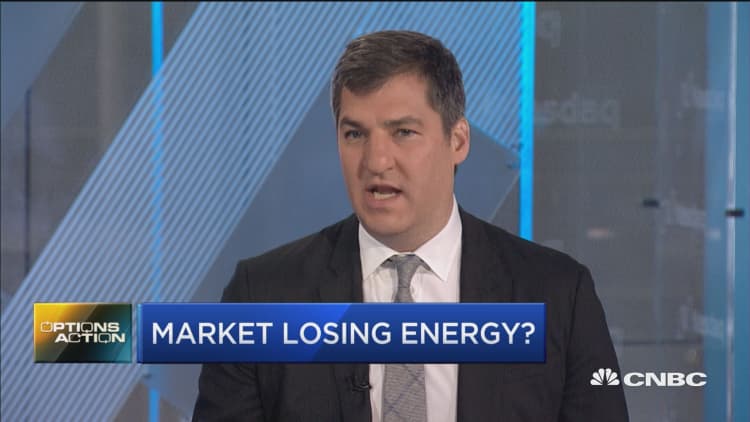The shale drillers behind booming U.S. oil and natural gas output have survived a bevy of challenges in recent years, from a historic oil price downturn to an effort by OPEC to wash them out of the market with a flood of cheap crude.
Now, with U.S. output at all-time highs near 12 million barrels per day, the industry is facing a new obstacle: how to keep growing output amid a wave of belt-tightening that is cutting billions of dollars from capital budgets.
Publicly traded shale drillers emerged from the 2014-2016 downturn with a new mandate from investors to get their finances in order and start generating value for shareholders. For years, drillers have spent more cash than they generated, borrowing heavily to snap up acreage and increase their output at seemingly any cost.
The latest round of quarterly earnings reports shows many shale drillers are cutting spending to meet investors' demands. That is translating into lower expectations for oil and gas output from the companies, which rely on advanced drilling methods like hydraulic fracturing to free oil and gas from shale rock formations.
But even with these frackers now pursuing the elusive goal of drilling at a profit, forecasters expect another blockbuster year for U.S. output. After surging by 1.6 million barrels per day last year, making the U.S. the world's biggest producer, average annual American output is poised to grow by more than 1.4 million bpd in 2019, according to the Department of Energy.
However, there's doubt about those forecasts in some corners of the market.
"We've seen a lot of people guide that 2019 [production] will be flat on the fourth quarter of this year, so while you'll see year-on-year growth in U.S. production, it's going to decelerate from '18 levels," said Ben Dell, managing partner at private equity fund Kimmeridge.
"Fundamentally I think supply estimates for the U.S will disappoint," he told CNBC's "Squawk Box" on Monday.
Heading into the earnings season, analysts at PiperJaffray's Simmons Energy expected oil and gas output from the exploration and production companies they cover to grow by 13 percent. Four weeks into the reporting period, they knocked their growth forecast down to 10 percent.
But as you drill down into the data, it becomes clear why total U.S. output continues to climb.
Drilling intelligence firm RS Energy currently expects the universe of companies it analyzes to cut spending by about 7 percent from last year.

But the lion's share of those cuts are coming from smaller companies like PDC Energy and Whiting Petroleum, firms with capital budgets below $1 billion a year. Small drillers covered by RS Energy are set to slash capital expenditures by 17 percent this year.
Meanwhile, total spending among big companies like EOG Resources and Pioneer Natural Resources is expected to fall just 4.5 percent. RS Energy projects these large players will pump about four times as much oil, natural gas and other liquids as their smaller competitors — and they'll spend five times as much even after cutting expenditures.
"The production that matters is coming from these big guys, and so it's not as clean of a story as saying, 'This cutting capex narrative is going to have a meaningful impact in 2019,'" said Dane Gregoris, senior vice president at RS Energy.
Barclays analysts see the same pattern in their coverage universe, with small- and mid-cap companies throttling back spending far more than large-cap drillers. But the group represents just a slice of publicly traded oil and gas companies, and Barclays warns that traders need to factor in private frackers.
Output from private drillers surged in the second half of 2018, contributing to a big jump in U.S. output in November. While public companies were adhering to investor demands to conserve capital, the private frackers were taking advantage of oil prices that hit nearly four-year highs last October.
However, those private drillers are now holding their fire, said Michael Cohen, head of commodities research at Barclays. Drilling activity is down, and companies aren't likely to ramp up fracking in the next few months, he said.
"It reinforces my view that the production growth profile for this year — at least in the first half — will not be as aggressive or shocking as what we saw in the second half of last year," he told CNBC.
The outlook gets murkier in the second half of 2019 though. That's when new pipelines and other infrastructure are scheduled to come online, clearing bottlenecks that are capping output from the Permian Basin, the top U.S. shale field spanning western Texas and southeastern New Mexico.
The anticipated surge in activity could lead to rising costs, as drillers compete for the equipment and services they need to frack their backlog of uncompleted wells. Rising completion costs could prevent runaway production growth, so long as companies continue to put financial discipline ahead of growth for growth's sake.
While there's any number of factors that could influence U.S. output, the single largest contributor will be the increase or decrease in fracking activity, including by private drillers, says Cohen.
The growing influence of oil majors like Chevron and Exxon Mobil in the Permian is also a new factor for analysts to consider. After sitting out the shale revolution for years, these behemoths are bringing industrial scale operations to the basin.
"We're seeing well results match what we're seeing from the independents, and it's really becoming a super major game now," Gregoris said.
Ultimately, RS Energy believes U.S. production will be about 1 million bpd higher at year-end compared with the close of 2018. However, Gregoris says the impact of 2019 spending cuts could show up in next year's U.S. production figures, with growth slowing to 800,000 bpd in 2020.
"In order to get the same growth in 2020 as we think you'll get in 2019, it's going to be a lot tougher," he said. "You're going to have to see capex ramp back up."
Correction: This story has been updated to show that RS Energy expects end-to-end U.S. oil production to grow by 1 million barrels per day in 2019 and 800,000 bpd in 2020.





